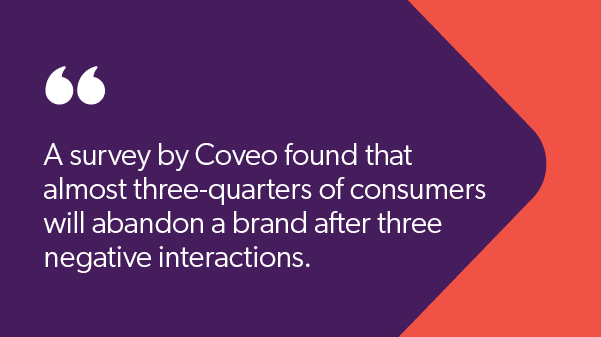The coronavirus pandemic has forced a wide variety of industries to rethink how they do business and to fast-track plans for digital transformation. The telecommunications business is no exception.
To explore what this transformation means, telco leaders in the UK and Ireland came together for a recent roundtable hosted by Coveo, a leader in search, recommendations and personalized digital experiences, and Salesforce, the world’s top customer relationship management platform.
Ben Wild, a UK-based account executive for Coveo, gave us a look at the key takeaways from the roundtable and expanded on how the telecom sector can evolve to meet customer expectations.
It’s Time for a ‘Critical Reinvention’
The Coveo-Salesforce roundtable was just part of the growing conversation about the need for change in telecommunications. Digital transformation was in the spotlight at Mobile World Congress in June. And McKinsey & Company laid out a blueprint this spring for a “critical reinvention” in telecom.

This moment is pivotal, McKinsey says, because “the pandemic accelerated and amplified trends that were already redefining the basis for success.” With lockdowns in effect, more customers of telecoms made purchases and sought service online instead of going to stores for face-to-face help.
As they did, they brought ever-increasing expectations to that customer interaction. A survey by Coveo found that almost three-quarters of consumers will abandon a brand after three negative interactions. When you consider that almost one-third of telecom customers report having trouble managing their plans online, that’s cause for concern.
“It’s now very easy for customers to leave their mobile network and self-source, as well as buy a sim,” Steve Rhodes, interim head of digital at Lebara, said during the roundtable. “It means, as a provider, your customer service has to be absolutely on point. Otherwise, that person could leave you just as quickly as they joined you.”
Personalization Is a Win-Win
So what does on-point service look like these days? The bar is high. Especially since the start of the pandemic, most consumers have gotten accustomed to dealing with brands like Amazon and Netflix that are masters at delivering effortless, relevant, and customized online experiences. Almost two-thirds of consumers now expect personalization as a standard of service.
Personalization looks different at different points of a consumer’s relationship with a telecom, Wild says. When they are trying to decide whether to become a customer in the first place, they want a telecom website to quickly understand their needs and help them accomplish their goals. Existing customers want to see relevant content, offers and promotions. And a customer who needs help or has a question wants fast answers and solutions.
Of course, these wins for the consumer also benefit a telecom company’s bottom line. A website that “gets” a prospective customer is more likely to drive conversions. Upselling is easier when the right messages get to receptive customers. And solving customer-service issues faster saves the company money.

Old Systems, New Expectations
Providing effective personalization is a challenge across industries. But telecommunications companies have their own unique set of circumstances as they face this challenge. On one hand, telecoms are data rich. “They know an enormous amount about me, about everybody because, basically, my entire life is based on my mobile phone,” Wild says. All of that information can be leveraged to create more relevant experiences.
On the other hand, telecoms have “big, complicated legacy systems,” that leave data in silos and create disjointed customer experiences, Wild says. Here’s an example: You call your mobile provider’s customer service line with a question. But then you get transferred between different customer service representatives “because they’re hooked into different areas of their back-office systems, so they don’t have visibility into all of the information which will help them answer questions,” he says.
Wild didn’t have to look any further than his own mobile phone for another example. After he purchased a new phone, he logged into his account and was served a marketing message encouraging him to upgrade his phone—to the one he had just bought.
“That’s clearly pulling in two different bits of information from two different systems,” he says. “They’re not talking to each other, and you’re having an inconsistent experience. And that, for me, is desperately fixable.”
Personalization Through AI Solutions
Those vast legacy systems aren’t going away overnight. But the telecom industry must start reinventing themselves now. McKinsey stresses that telecom operators that don’t make bold moves this year risk their very futures.
One of those bold moves should be honing their “ability to leverage data and deploy advanced analytics, artificial intelligence, and automation at scale to drive new sources of growth and change the broader economics of the business.”
Participants in the Coveo-Salesforce roundtable shared a similar vision for the future. “You need to leverage machine learning to be able to ingest all of those different data sources,” Wild says.
How could artificial intelligence and machine learning change what customer interactions with telecommunications companies look like?
- Predictive analytics can make the customer acquisition process more personalized. “I think the interesting thing about customer acquisition is that personalization to an anonymous audience is a challenge,” Wild says. “You don’t know who this person is, and, therefore, how can you personalize? But that’s where the magic of machine learning comes in – because we don’t know that individual, but we know a whole heap of other people that have done similar things before and exhibited similar behaviors, and machine learning can very quickly pick up patterns.” (For a detailed look at AI-powered personalization even for first-time site visitors, check out our article “Powerful Personalization in Ecommerce – No Big Data Required.”)
- With existing customers, machine learning continues to spot patterns. Let’s go back to the example of the promo message Wild received encouraging him to buy the same phone he had already purchased. By effectively using machine learning, this service provider could have had a better sense of what Wild would be interested in based on what other customers like him had done in the past. So instead of the irrelevant promotion, Wild would have seen an upsell offer that other people like him responded to. “Machine learning has determined what is likely to get the best result at any given moment,” he says.
- When it comes to customer service, machine learning helps telecom customers resolve their own needs through self-service. For example, a telecom website learns that most visitors who searched for Question A on their website reported that Video B gave them the information they needed. So now when people search for Question A, the site starts taking them immediately to Video B.
Machine learning also helps customer service representatives work around data silos. Remember how we talked earlier about the experience of getting transferred among different reps? Representatives can help a customer more quickly, and even identify upsell opportunities they could not have before, if they’re using technology that delivers a complete and non-fragmented view of that customer.
“This allows telcos to provide a better service, handle calls quicker, achieve resolutions more speedily, driving customer retention,” Dan Oldridge, regional sales director for service cloud at Salesforce, said during the roundtable.
At the end of the day, it’s about making every interaction feel personal and customized to show a telecom customer how important they are to the company.
“Artificial intelligence is also going to make the customer experience more human, not less,” Oldridge said. “It’s going to be about using data to create a better service. Human interaction isn’t going away. Once we get all the data into a single source of the truth about the customer, it’s going to drive a whole new level of deep relationships with customers, which can bring all kinds of other possibilities, whatever the future brings.”
Dig Deeper
Wondering if a ‘leaky bucket’ is affecting your CLV? Here’s why relevance is key to customer retention.
Learn more about using AI technology to create intelligent shopping and service journeys with our ebooks, Your Guide to Delivering Intelligent Shopping Experiences and Win and Grow Customers in the Experience Economy with Headless Ecommerce.


